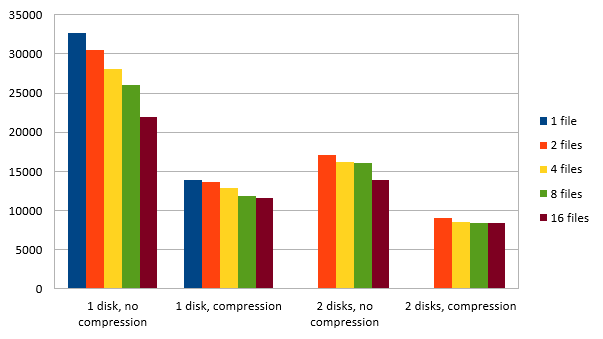Speeding up your backups
March 30, 2015 4 Comments
Last week, I watched the SQLRally session of Pieter Vanhove (Blog | @Pieter_Vanhove), where he talked about Advanced Backup and Restore. He mentioned striped backups (taking a backup of a database, divided over a number of files). After watching the video, I started to wonder what made the biggest difference: the number of files, the number of disks, compression.
Test setup
In order to test this, I restored a copy of the AdventureWorks2012 database, that you can download from msftdbprodsamples.codeplex.com. But because this database is only 200MB, taking a backup would only take a second. In order to make this a bit more interesting, I used a script Adam Machanic (Blog | @AdamMachanic) wrote. This script creates 2 new objects in the AdventureWorks database (dbo.bigProduct and dbo.bigTransactionHistory), which results in a database of 2.8GB. You can download the script here.
What matters most?
In order to test the differences in performance, I’ve tested multiple combinations:
– Multiple files on single disk
– Multiple files on 2 disks
– Both options above, with and without backup compressions
After running all the different tests, I’ve added the results to an Excel sheet:

The results you see are in milliseconds. The analysis on these numbers is a bit difficult, so let’s put these numbers in a graph:

As you can see, the number of files (when looking at a minimum of 2 files) isn’t the biggest difference. The number of disks, and compression vs no compression make the biggest difference. In my case, I tested it on 2 SSD’s, but you may have more disks in your server. Or better yet, you are able to take backups on multiple LUN’s on your storage, and the LUN’s use multiple disks. The more spindles you can use, the faster your backup will become.
But there’s also a downside to this. When you want to restore a backup, you need all the files to do that. So when you restore a normal backup, you only need 1 file. If you’re going to stripe your backup over 16 files for example, you need all 16 files to perform a restore. So basically, the chance of having a corrupt backup file is 16x as high, compared to a normal (single file) backup. For every advantage, there’s always a disadvantage…
If you want to read more about backups, don’t forget to check out these blog posts:
– Julie Koesmarno: On sabbatical
– Mickey Stuewe: Transaction Log Backups for the Accidental DBA
– Chris Yates: Backups – They Are Needed, Who Knew?

Pingback: Backups – They Are Needed, Who Knew? | The SQL Professor
Pingback: SQL Server
Pingback: Transaction Log Backups for the Accidental DBA | Mickey's T-SQL Ponderings
Pingback: Backups – They Are Needed, Who Knew? - SQL Server - SQL Server - Toad World